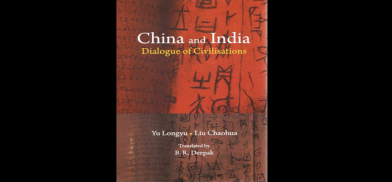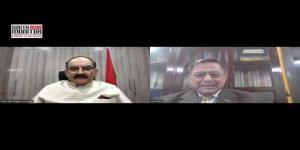A mind-boggling study of literary dialogue between the Asian giants
Chinese scholarship has picked up works written not only in Sanskrit and Hindi, but also in Bengali, Tamil, Urdu and English

Professor B. R. Deepak’s translated volume titled ‘China and India: Dialogue of Civilizations’ opens a not much known but very significant amount of civilizational dialogue between India and China over the last two millennia. The book is one of the volumes in the History of the Sino-Foreign Literary Exchange series (total 17 volumes) written by Professor Yu Longyu and Liu Zhaohua in Chinese.
The 700 pages plus volume is a mind-boggling in-depth study of the literary dialogue between the two Asian giants right from the dissemination of Buddhism to China till the present day. The book with prefaces by the translator and the authors, introduction, 16 chapters, a substantial postscript, and a long chronology of India-China interaction that incorporates reference books too, is a rich and invaluable reference repository.
The first three chapters of the 683-page volume focus on the literary exchanges under the umbrella of Buddhism and cover issues such as the Sutra translation, influence of Buddhist literature on Chinese language and literature, the birth of China’s translation studies etc. The study reveals that in a span of 734 years starting from the 10th year of the Yongping Era in Han Dynasty (67 A.D.) to the 16th year of Zhenyuan Era in Tang Dynasty (800 A.D.), in all 185 prominent translators translated 2412 sutras running into 7352 fascicles.
It was in the process of sutra translation in China that more than 35,000 Sanskrit entries were incorporated into Chinese language, and the language itself got transformed into a tonal and multisyllabic one since then. Various facets of Chinese literature, art, music, theatre and astronomy were influenced by the Indian culture, the imprints of which have been discussed in the study in detail.
The next three chapters (4-6) focusing on the transmission of Indian fables, myths and theatre into China, dissemination of the Ramayana and Mahabharata and the adaptation of certain contents from these into Chinese and Buddhist literature are quite interesting. Three Jataka stories – King Dasharatha, Monkey King, and Shambuka - the earliest and most conclusive texts of dissemination of the Ramayana to China, are discussed. All narrate Ramayana but in a Buddhist setting; tweaking of the characters, and time and place has certain digressions, which is a phenomenon that can be traced to the Indian subcontinent as well as Southeast Asia.
The focus of the next five chapters (7-11) is on the leading Indologists of China and their research on India’s classical and modern literary works. It starts from the translation of Tagore in China, and then discusses the contribution of Padma Bhushan Ji Xianlin, Xu Fancheng, Jin Kemu, Huang Baosheng and Liu Anwu to the India-China literary dialogue and cultural exchanges of contemporary times.
Some of the names may be known in India. However, the contribution of Xu Fancheng, who spent 27 years in Sri Aurobindo Ashram and happens to be the first Chinese to translate the Upanishads, remains buried not only in India but also in China for a long time. At the end of these chapters, the research of contemporary Chinese scholars on India is also given as an appendix.
These scholars continued the fine tradition of sutra translation in China.
The translation and publication of Bhagavad-Gita in the 1940s, Upanishads in the 1950s, Kalidasa’s Abhijnanashakuntala and Meghaduta in the 1950s and 1960s, the Ramayana from Sanskrit in the 1980s, Ramcharitmanas in 1988, Rabindranath Tagore’s works in 24 volumes in 2000, the complete Mahabharata from Sanskrit in 2005, various editions of Manusmriti; Sursagar and Kabir Granthavali in 2018-19 bear testimony to the grand efferts.
Apart from the scattered translation of the Vedas, it could be said that China has translated almost the entire repository of mainstream Indian literature and philosophy including the Panchatantra, Kathasagar, six philosophical Schools of India, and teachings of Shankaracharya into Chinese.
Chapters 12 and 13 make a good case study of the Chinese studies in India and the contribution of Tan Yunshan and P. C Bagchi towards the same.
Chapter 14 expounds Osho’s contribution towards popularising Laozi and Zhuangzi or say Taoism in India and beyond. It also talks about the Osho phenomenon in China at one time. Chapter 15 is on China in Raja Rao’s writings, and the last chapter discusses the kind of work being done in India and China by the present generation of Indian Sinologists and Chinese Indologists.
The chapters also delve into the kind of Indian literary works that have been researched by the Chinese scholars. These include works of writers such as Bharatendu Harishchandra, Premchand, Yashpal, Mirza Ghalib, Mohamed Iqbal, Krishan Chander, Jai Shankar Prasad, Jainendra Kumar, Phanishwar Nath Renu, Bankim Chandra Chatterjee, Aurobindo, Osho. The list goes on.
What is interesting is that Chinese scholars have also studied and rendered in Chinese the Indian writings in Tamil and English. The works of Chinnaswami, Subramania Bharathi, Mulk Raj Anand, R. K. Narayan, Raja Rao, Bhabani Bhattacharya, Manohar Malgonkar, Arun Joshi, Khushwant Singh, Vikram Seth and Anita Desai have been extensively translated and studied. Even though the import of Indian films in China is limited, the translation and dubbing of movies right from Raj Kapoor’s Awaara to Amir Khan’s Dangal has gone unstopped as mentioned in the bulky chronology of India-China relations given at the end of the book.
Chinese scholarship has picked up works written not only in Sanskrit and Hindi, but also in Bengali, Tamil, Urdu and English. No wonder, many universities across China are offering languages like Hindi, Tamil, Bengali and Punjabi t undergraduate and postgraduate levels.
The fine tradition laid down by stalwarts like Ji Xianlin, Xu Fancheng, Jin Kemu, Huang Baosheng and Liu Anwu has been kept alive by their students such as Wang Shuying, Jin Dinghan, Xue Keqiao, Wang Bangwei, Yu Longyu and Jiang Jingkui who in turn have trained a formidable team of young Indologists spread across China.
Obviously, such capacity building is not possible without policy formulation, funding and support from the top. Conversely, in India we have to do a lot in terms of building capacities in Chinese language and studies.
Deepak believes that through this translation, people on both sides of the Himalayas will have a better understanding of the cultural, literary and people to people relations between India and China. It will open new enquires for research and be beneficial for the researchers and students of India-China relations, literary studies, Buddhist studies, translation studies, comparative literature, oriental studies, and even studies on individuals such as Tagore, Ji Xianlin, Jin Kemu, Xu Fancheng, P. C. Bagchi, Tan Yunshan, Raja Rao, Osho and many more.
Deepak studied at Peking University, Beijing, from 1991 to 1993, and again in 1996 studied as a Jawaharlal Nehru Fellow at the Chinese Academy of Social Sciences in Beijing. One of the five awards he received is the Special Book Award from the Government of China in 2011 for Translation of Chinese Classical Poetry into Hindi.
The book should be stocked by all universities and think tanks and must be made good and subtle use of by the government in diplomatic, political, cultural and even military dealings. Like the Peoples Liberation Army, which makes much use of loudspeakers for propaganda along the Line of Actual Control, Indian Army should reciprocate similarly to convey in Chinese language some suitable material from this book.
(China and India: Dialogue of Civilisations; Author Yu Longyu and Liu Zhaohua; translated from Chinese into English by B. R. Deepak; Publisher Pentagon; Pages 683; Price Rs. 2995/-)
(The reviewer is a strategic analyst and former Defence Ministry and Indian Army spokesperson. Views expressed are personal. He can be contacted at wordsword02@gmail.com.)










Post a Comment